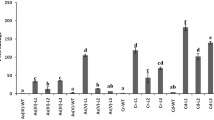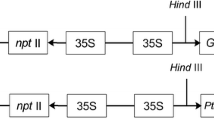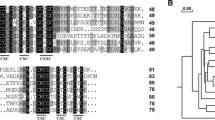Abstract
Metallothionein (MT) is a cysteine-rich, low-molecular-weight protein that can bind to cadmium ions and reduce their toxicity to plants. In this study, we cloned the PaMT3-1 gene encoding an unstable protein of 63 amino acids from the cadmium hyperaccumulator Phytolacca americana. The gene was inserted into a plant expression vector and introduced into tobacco plants. The cadmium content of the transgenic plants was measured after treatment with 100 mM CdCl2 for 7 days. Transgenic and wild-type roots had similar cadmium contents, whereas the cadmium content of transgenic leaves was 66.28–78.70% of the wild type. The transport coefficient of cadmium in transgenic plants was decreased by 23.31–35.52% relative to the wild type. According to various physiological indexes, including malondialdehyde content, relative electrolyte leakage, root activity, and soluble sugar content, the transgenic plants performed better than the wild type. The PaMT3-1 gene can significantly improve plant resistance to cadmium and has potential as an important gene resource in phytoremediation. Our findings could also contribute to an understanding of complex processes and mechanisms involved in phytoremediation.
Key message
Over-expressing a metallothionein gene PaMT3-1 from Phytolacca americana in tobacco plants showed enhanced cadmium tolerance that would be important gene resource for phytoremediation.






Similar content being viewed by others
References
Chen Y, Liu Y, Ding Y et al (2015) Overexpression of PtPCS enhances cadmium tolerance and cadmium accumulation in tobacco. Plant Cell Tissue Organ Cul 121(2):389–396
Chen Y, Zhi J, Li X et al (2018) Diversity in cadmium accumulation and resistance associated with various metallothionein genes (type III) in Phytolacca americana L. Int J Biol Macromol 108:704–709
Chen Y, Zhi J, Zhang, et al (2017) Transcriptome analysis of Phytolacca americana L. in response to cadmium stress. Plos One 12(9):e0184681
Cobbett C, Goldsbrough P (2002) Phytochelatins and metallothioneins: roles in heavy metal detoxification and homeostasis. Ann Rev Plant Biol 53(1):159–182
Curie C, Cassin G, Couch D et al (2009) Metal movement within the plant: contribution of nicotianamine and yellow stripe 1-like transporters. Ann Bot 103(1):1–11
Gorinova N, Nedkovska M, Todorovska E et al (2007) Improved phytoaccumulation of cadmium by genetically modified tobacco plants (Nicotiana tabacum L.) Physiological and biochemical response of the transformants to cadmium toxicity. Environ Pollut 145(1):161–170
Hernandez-allica J, Garbisu C, Becerril JM et al (2006) Synthesis of low molecular weight thiols in response to Cd exposure in Thlaspi caerulescens. Plant Cell Environ 29(7):1422–1429
Lee J, Donghwan S, Won-yong S et al (2004) Arabidopsis metallothioneins 2a and 3 enhance resistance to cadmium when expressed in Vicia faba guard cells. Plant Mol Biol 54(6):805–815
Li W, Zhang J, Zhang X et al (2001) Pb tolerance and accumulation of Petunia transformed by metallothionein recombinant αα gene. Progress Biochem Biophys 28(3):405–409
Liu H, Li H, Zhang H et al (2016) The expansin gene PttEXPA8 from poplar (Populus tomentosa) confers heat resistance in transgenic tobacco. Plant Cell Tissue Organ Cult 126(2):353–359
Mobin M, Khan NA (2007) Photosynthetic activity, pigment composition and antioxidative response of two mustard (Brassica juncea) cultivars differing in photosynthetic capacity subjected to cadmium stress. J Plant Physiol 164(5):601–610
Nakanishi-Masuno T, Shitan N, Sugiyama A et al (2018) The Crotalaria juncea metal transporter CjNRAMP1 has a high Fe uptake activity, even in an environment with high Cd contamination. Int J Phytoremed 20(14):1427
Paterson AH, Wendel JF, Gundlach H et al (2012) Repeated polyploidization of Gossypium genomes and the evolution of spinnable cotton fibres. Nature 492(7429):423–427
Peng JS, Ding G, Meng S et al (2017) Enhanced metal tolerance correlates with heterotypic variation in SpMTL, a metallothionein-like protein from the hyperaccumulator Sedum plumbizincicola. Plant, Cell Environ 40(8):1368–1378
Schat H, Llugany M, Vooijs R et al (2002) The role of phytochelatins in constitutive and adaptive heavy metal tolerances in hyperaccumulator and non-hyperaccumulator metallophytes. J Exp Bot 53(379):2381–2392
Sierro N, Battey JN, Ouadi S et al (2013) Reference genomes and transcriptomes of Nicotiana sylvestris and Nicotiana tomentosiformis. Gen Biol 14(6):1–17
Stephenson C, Black CR (2014) One step forward, two steps back: the evolution of phytoremediation into commercial technologies. Biosci Horizons 7:1–15
Suh N, Honda T, Finlay HJ et al (1998) Novel triterpenoids suppress inducible nitric oxide synthase (iNOS) and inducible cyclooxygenase (COX-2) in mouse macrophages. Can Res 58(4):717–723
Turchi A, Tamantini I, Camussi AM et al (2012) Expression of a metallothionein A1 gene of Pisum sativum in white poplar enhances tolerance and accumulation of zinc and copper. Plant Sci 183:50–56
Wang B, Guo X, Wang C et al (2015) Identification and characterization of plant-specific NAC gene family in canola (Brassica napus L) reveal novel members involved in cell death. Plant Mol Biol 87(4):395–411
Wang L, Xia Q, Zhang Y et al (2016) Updated sesame genome assembly and fine mapping of plant height and seed coat color QTLs using a new high-density genetic map. BMC Genom 17(1):31–31
Wang X, Zhi J, Liu X et al (2018) Transgenic tobacco plants expressing a P1B-ATPase gene from Populus tomentosa Carr. (PtoHMA5) demonstrate improved cadmium transport. Int J Biol Macromol 113:655–661
Willing E, Rawat V, Mandakova T et al (2015) Genome expansion of Arabis alpina linked with retrotransposition and reduced symmetric DNA methylation. Nature Plants 1(2):14023–14023
Wu GA, Terol J, Ibanez V et al (2018) Genomics of the origin and evolution of Citrus. Nature 554(7692):311–316
Yang J, Chen Z, Wu S et al (2015) Overexpression of the Tamarix hispida ThMT3 gene increases copper tolerance and adventitious root induction in Salix matsudana Koidz. Plant Cell, Tissue Organ Cult 121(2):469–479
Zhang B, Georgiev O, Hagmann M et al (2003) Activity of metal-responsive transcription factor 1 by toxic heavy metals and H2O2 in vitro is modulated by metallothionein. Mol Cell Biol 23(23):8471–8485
Zhang H, Liu H, Yang R et al (2019) Over-expression of PttEXPA8 gene showed various resistances to diverse stresses. Int J Biol Macromol 130:50–57
Zhang J, Zhang M, Tian S et al (2014) Metallothionein 2 (SaMT2) from Sedum alfredii Hance confers increased Cd tolerance and accumulation in yeast and tobacco. Plos one 9(7):e102750
Zhao F, Wang J, Barker JHA et al (2003) The role of phytochelatins in arsenic tolerance in the hyperaccumulator Pteris vittata. New Phytol 159(2):403–410
Zimeri AM, Dhankher OP, McCaig B et al (2005) The plant MT1 metallothioneins are stabilized by binding cadmiums and are required for cadmium tolerance and accumulation. Plant Mol Biology 58(6):839–855
Acknowledgements
The research was granted by Beijing Natural Science Foundation (#5122019) and the Fundamental Research Funds for the Central Universities Grants (No. 2015ZCQ-SW-01)
Author information
Authors and Affiliations
Contributions
All authors contributed to the study conception and design. ZJ and LX performed material preparation and research; YP, YR and LJ analyzed data; ZJ and XJ wrote the paper. All authors read and approved the final manuscript.
Corresponding author
Additional information
Communicated by Mohammad Faisal.
Publisher's Note
Springer Nature remains neutral with regard to jurisdictional claims in published maps and institutional affiliations.
Rights and permissions
About this article
Cite this article
Zhi, J., Liu, X., Yin, P. et al. Overexpression of the metallothionein gene PaMT3-1 from Phytolacca americana enhances plant tolerance to cadmium. Plant Cell Tiss Organ Cult 143, 211–218 (2020). https://doi.org/10.1007/s11240-020-01914-2
Received:
Accepted:
Published:
Issue Date:
DOI: https://doi.org/10.1007/s11240-020-01914-2




